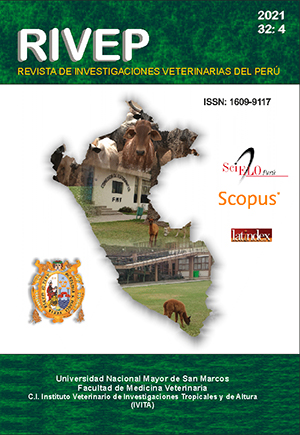A contribution to the understanding of the culture in phases of the freshwater prawn Macrobrachium rosenbergii in Costa Rica
DOI:
https://doi.org/10.15381/rivep.v32i4.20938Keywords:
prawns, Macrobrachium rosenbergii, planting density, compensatory growth, productivityAbstract
The aim of this study was to contribute to the understanding of the effects of phased cultivation on the productivity and the compensatory change of Macrobrachium rosenbergii prawns to increase the intensity of the cultivation and manage the heterogeneous growth through size separation. The study was carried out in an aquaculture farm in the Caribbean region of Costa Rica. A concrete pool measuring 12 m2 x 0.5 m deep was used as nursery and two earthen ponds covered with plastic measuring 72 m2 x 0.8 m deep for the development and fattening phases. The nursery pool was divided in two and the stocking densities were 91.6/m2 per section. In the nursery they were harvested with an average 2.5 g to stock the development pond divided in two at a density of 12.5/m2 per section. In development they were harvested again with an average 7.3 g (1.3-19.5 g). They were separated by size using a net and the large ones were transferred with an average weight of 10.4 g in one pond at 6.1/m2 and the small ones with an average 4.1 g in another at 4.8/m2. The productions were 191.1 g/m2 in nursery, 79.9 g/m2 in development and 77.6 g/m2 in fattening. The productive yield indices indicated slow progress with the transfer from nursery to development and fattening, lowering the stocking densities, except when they were separated by size, where the small ones considerably increased the initial biomass (2.7 times) and contributed to 50% of the fattening production. The average productivity was 1128 kg/ha/year, but since phased cultivation allows up to 3.5 fattening cycles per year, productivity can be increased to 2716 kg/ha/year. When separating the prawns by size to stock them in the fattening, compensatory growth was noted in those belonging to the fraction of the large ones within a wide range of size variability. The percentage of the weight of the tail decreased with the increase in the size of the animal and was greater for the females than for the males due to the smaller size and weight of their claws. The preliminary results of this study indicate that cultivation in phases can increase productivity by being able to carry out more cycles per year and the separation of sizes to improve the crop size of small prawns.
Downloads
Downloads
Published
Issue
Section
License
Copyright (c) 2021 José Valverde

This work is licensed under a Creative Commons Attribution 4.0 International License.
AUTHORS RETAIN THEIR RIGHTS:
a. Authors retain their trade mark rights and patent, and also on any process or procedure described in the article.
b. Authors retain their right to share, copy, distribute, perform and publicly communicate their article (eg, to place their article in an institutional repository or publish it in a book), with an acknowledgment of its initial publication in the Revista de Investigaciones Veterinarias del Perú (RIVEP).
c. Authors retain theirs right to make a subsequent publication of their work, to use the article or any part thereof (eg a compilation of his papers, lecture notes, thesis, or a book), always indicating the source of publication (the originator of the work, journal, volume, number and date).










